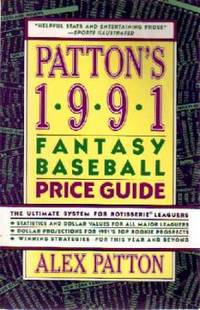Dear Rotoman:
As a league that’s been around for 30 years, we’ve played by the rules that Alex Patton established in his book, and have made sure we changed the ones he did in newer books. Since he hasn’t put out a book in several years, many in our league are wanting to know if some of our rules are outdated and need to be changed, dropped or modified.
We play NL, 5×5 (HR,R,SB,OBP,RBI and W,S,K,ERA,WHIP), $280 starting salary, $340 in season cap, 25 players with Farm Team. Three year contracts with extensions at $5 per year. We do $100 FAAB from after All-Star til last week of August. FAAB over $10 must be kept next year or dropped for $10 salary penalty.
Anyway, do you know if most teams still use these same basic rules or have any of them mostly changed. The one I want to modify is to make FAAB all year vs. six weeks. Currently, early in the season, lower ranked teams are “rewarded” by drafting guys that don’t play or will soon be sent down, to wait and see the two or three guys we all miss in the draft each year. The league winner last year screwed his draft and left with $60+ dollars, only to pick up Erving Santana, Hector Rondon and Aaron Harang the first three weeks of the season. Personally, I feel like every player needs to be FAAB eligible so that EVERY OWNER has a chance. Higher ranked teams cannot get these guys for DL selections because lower teams are holding their DL guys several weeks to see if someone good comes up.
Any input you can give us would be greatly appreciated as it relates to how most leagues deal with things these days.
“Old Ruled”
What’s funny is that I’ve played with Alex Patton in the American Dream League, which was something of the model league in his books, for more than 20 years, and our rules are totally unlike yours. I’ll be brief: AL, 4×4 (BA), $260 budget, no salary cap, 24 man rosters with seven man reserve. One year contract with no escalator. $50 FAAB starting the third week, and then all season long.
Crazy no?
The fact of the matter is that your league is much more progressive, with your 5×5 and OBP, particularly, than the ADL is. Which doesn’t mean that rules can’t or shouldn’t be changed. There’s just no reason to try to conform to any one set of rules, because you can’t. There are people playing in so many styles I hesitate to list them, because I’m nodding off just thinking about them.
Which brings us to your crazy FAAB rule. Yes, I said crazy, because I think you guys have it all backward.
In the old days, before their was FAAB in Fantasyland, the waiver wire ruled supreme. Whoever got their claim in first, when a player “came over,” (as we still say though without the frenzied dialing), would acquire the player. But everyone soon realized that this gave such an advantage to the unemployed obsessive they wished they could be, that weekly waivers became more the norm.
The problem with weekly waivers is that priority goes to the bad teams, the teams lower in the standings, which means they acquire talent that all too often would get traded to one of the good teams, thus making all the other competing teams angry. Hence, FAAB.
FAAB is an equalizer. It gives each of us the chance to make the market on a particular player on a particular day. And if we blow our wad one day, the teams that still have FAAB left have the advantage. Which is why it is perfect tool for leagues to use all season long.
In fact, relegating it to a brief period means there is no warp and woof to the budgets. I would imagine players are traded over from the AL and everybody goes all in on them, and they’re awarded to the team lowest in the standings on the tie-breaker. That misses the point.
I mentioned that in the ADL we wait three weeks to start up our FAAB. This is a vestige of our time before FAAB. We held up waivers until there was some settling in the standings, a bubbling up of talent, a dropping down of not so much, so that good teams off to a bad start weren’t unjustly rewarded. Some argue that since we use FAAB now we could start waivers Week 1, and they’re right. But I resist that.
Having a week or two, or even three, before teams can beef up their rosters is a test for teams that take players in the auction who are injured. The idea is no more an impetus to force them to find a replacement than the Affordable Care Act was intended to compel the States to set up their own exchanges. Rather, the goal is to inflict on them a little pain if they don’t draft a replacement. Isn’t that fun?
As for some of the other crazy new rules the kids are coming up with, OR, don’t get me started. Have you heard of the Daily Games?



